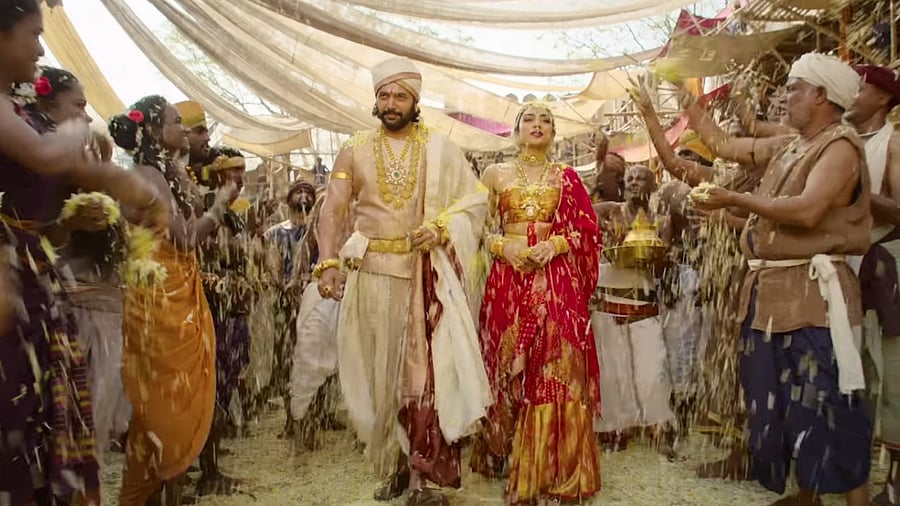
A still from 'Ponniyin Selvan'.
Credit: YouTube/Lyca Productions
Recently, the Delhi High Court set aside the interim injunction against A R Rahman in the copyright dispute over the song Veera Raja Veera. The plaintiff, the Dagar family, had alleged that the song copied their Dhrupad composition Shiva Stuti. The Court found, however, that their evidence—largely stage performances—did not conclusively prove authorship of the specific composition.
In classical music, where oral tradition prevails, performance alone cannot establish copyright. The court clarified that the burden of proof rests entirely on the plaintiff, who failed to produce concrete evidence of authorship. The absence of contradictory material does not validate ownership claims. The court also noted that classical compositions are often rooted in traditional ragas and taals, which belong to the public domain and cannot be monopolised. Hence, Rahman and the producers are not currently obliged to provide credit or compensation until the issue is settled.
The central question remains: Is Veera Raja Veera a copy, an interpretation, or simply inspired by the Dagar Brothers’ Shiva Stuti? Do the Dagars hold rights merely because they performed it decades ago? A similar debate surrounds the song Varaha Roopam from the film Kantara, which closely resembles a composition by Thaikkudam Bridge. To the average listener, such songs may sound almost identical, while trained musicians can often discern subtle differences in notes and swaras. Yet copyright disputes are not judged by popular opinion. Courts may acknowledge similarities but decide strictly according to law.
This exposes the grey zones and loopholes in copyright law that some composers—knowingly or otherwise—might exploit. Two songs may sound nearly the same, yet slight variations in melody, rhythm, or arrangement may be enough for a court to consider one “original.” Copyright law also excludes “inspiration” from infringement, complicating matters further. In classical and semi-classical genres, the question of ownership is particularly ambiguous. Can one truly claim authorship over a raga-based composition or a traditional piece transmitted orally through generations? In Hindustani classical music, many compositions share ragas and talas, differing only slightly in lyrics or ornamentation. Each gharana often presents its own variation of the same composition. Fortunately, the works of saints such as Tyagaraja and Purandaradasa in Karnatic music belong to the public domain. Yet one worries that a time might come when even such classical treasures are contested as private property.
The ethical question also looms: Is it fair for celebrated composers to borrow traditional melodies without acknowledgment? In Rahman’s case, even if the Dagars cannot legally prove authorship, a simple acknowledgement of inspiration would have demonstrated humility and respect for the classical tradition. This concern is not limited to Rahman—many prominent composers, including Pritam, Anu Malik, Hamsalekha, R D Burman, and Ilayaraja, have faced similar accusations of uncredited borrowing. Though legal proof is elusive, many listeners find such practices disappointing.
In the film industry, commercial success often overshadows ethical considerations. Whether a song is copied, inspired, or original, once it resonates with the audience, it is celebrated. But does escaping legal scrutiny justify copying others’ work? While film music thrives on creativity and mass appeal, ignoring ethical accountability erodes artistic integrity. Copying without acknowledgement distorts cultural heritage and undermines respect for original creators. The law may permit such actions through technicalities, but from the standpoint of fairness and musicianship, they remain troubling.
Balancing creativity with ethics ensures that inspiration does not turn into exploitation. When composers credit their influences, they enrich the cultural dialogue rather than diminish it. Interestingly, this contemporary debate echoes India’s historical experience of forced musical fusion. During the Mughal and Sultanate eras, the blending of Hindu, Persian, and Arabic musical traditions—often under royal patronage—produced new forms such as khayal, which now dominates Hindustani classical music. This fusion, though artistically fruitful, emerged largely from power dynamics and cultural control. People had no choice but to accept these as symbols of projected harmony. Similarly, today’s audiences have limited agency in accepting trends shaped by powerful film industries and market forces.
In both past and present, those at the top often decide what becomes ‘acceptable’. Thus, while musical blending is often beneficial, the ethics of attribution must evolve alongside it.
The Veera Raja Veera controversy is more than a legal dispute; it reflects a broader tension between law, creativity, and ethics. Copyright may protect form, but not always the soul of art. As audiences and artists, we must advocate for a culture in which inspiration is celebrated, but honesty and respect remain non-negotiable.
(The writer is a state award-winning playback singer, actor, engineer, and former national medallist in gymnastics and fencing)
Disclaimer: The views expressed above are the author's own. They do not necessarily reflect the views of DH.